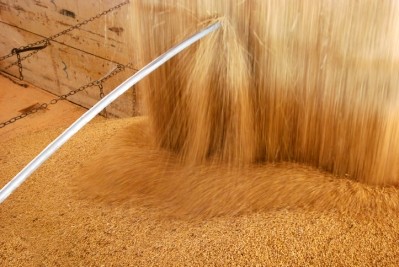US: Feed crop prices fall following WASDE data release

The US Department of Agriculture (USDA) released updated information about feed crop production and trade on Monday [Aug. 12] in a World Agricultural Supply and Demand Estimates report.
Overall, the US soybean crop lost 3.3m acres and saw production drop 165m bushels, said Chad Hart, associate professor of economics, crop market specialist and extension economist at Iowa State University. Adding, "That helped create some room, which we needed because there was a downgrade on the demand side … In the grand scheme of things it was about a 40m bushel downgrade in terms of those ending stocks as we look at August of 2020."
“On its face, it would have been a neutral to slightly bullish report for soybeans,” he told FeedNavigator. “But when you put it all together – it was just a bad day to be out on the marketplace today. Soybeans went down today not because of its own numbers, but because of what was happening in other markets.”
Prices for corn fell across the board and further declines are anticipated, he said. "Every contract was limit down today - that says from a trade perspective this was definitely not what they were expecting," he added.
There was an expectation that prevented plant acres would show up in corn, which did not happen to the level anticipated as planting was only trimmed about 1.7m acres, he said. “Area came down, but the yield came up and, in this case, when we put the two together actual production estimates went up by about 26m bushels,” he added.
“Right now, we’re staring at more corn being available than the market was prepared for,” he said. “You have supplies going up, [and] demand going down, which is not a good recipe in this marketplace right now except for a feed perspective.”
Information on this year's production has been slow and the anticipation is information may continue to be behind through harvest, Hart said. “This may be one of those [times] when even when we get the January [report] and the final numbers we still have questions about what actually happened,” he added.
Concerns about the quality of the corn and soybeans raised this year will be another element influencing the volatility of the feed market, said Hart. “Going through this harvest season what it is that we’ll be talking about is those quality issues,” he added.
“Moisture leads you down the line of talking about diseases and mold, but we’ll also be worried about will the test weight be there and what’s the protein,” he said. “The uncertainty that started with trying to get this crop planted has just continued to loom over it as it develops and matures, and what does that mean to the final product when we go to feed it?”
Corn surprises
The US corn outlook for 2019/20 anticipates a larger production and ending stocks following a decline in exports and ethanol production, the USDA said.
Corn production is forecast up 26m bushels to 13.9bn bushels as a reduction in harvested acres is balanced by a bump in yield, the department said. Initial survey results indicate production at 169.5 bushels an acre – up 3.5 from last month.
“Illinois, Indiana, Iowa, Minnesota, Nebraska, Ohio, and South Dakota are forecast to have yields below a year ago,” the USDA reported. “Of the major producing states, only Missouri is forecast to have yields above a year ago.”
Corn use in ethanol is predicted to decline 25m bushels, exports fell in the face of increased competition from Argentina, Brazil and Ukraine and ending stocks were raised 171m bushels, the department said. Season-average corn price was lowered $0.10 to $3.60 a bushel.
Internationally, coarse grain production is forecast to have higher trade, production and stocks, the USDA said. Corn production was increased for Ukraine, the EU, Romania, Hungary and Bulgaria while barley production is up in Argentina and Russia.
Corn exports from Ukraine and Serbia are anticipated to offset trade declines from Russia, in 2019/20, the department said. Exports from Argentina and Brazil also increased.
Imports in 2019/20 are also expected to grow, particularly for the EU and Indonesia, while use in China is predicted to decline, the department said.
Overall, ending stocks are trending higher, the department said.
Oilseed, soybean statistics
In 2018/19 soybean crush is down stemming from the reduction in domestic use and exports of soybean meal, the USDA said.
Overall, US oilseed production in 2019/20 is expected to be 111.5m tons – a drop of 4.5m from earlier estimates based on production forecast, the USDA said. Soybean production is expected to be 3.68bn bushels – a decline of 165m bushels stemming from the harvested area.
Harvested area for soybeans was reduced to 75.9m acres – with primary declines in Ohio and South Dakota, the department reported.
Anticipated soybean yield is 48.5 bushels an acre, down 3.1 bushels from last year, the department said.
Soybean supplies in 2019/20 were trimmed 3% to 4.77bn bushels, the USDA said. Anticipated exports fell 100m bushels based on the decline in global demand – particularly from China – and ending stocks were set at 755m.
The season-average price for soybeans remains $8.40 a bushel, with soybean meal priced at $300 a short ton, the department said.
Globally, oilseed production is anticipated to have lower production and trade based on the reduction in soybean, rapeseed and peanut production, the department said. International exports also fell, dropping about 3m tons related to a lack of imports by China.
World ending stocks for soybeans in 2019/20 are expected to drop based on reduced stocks in the US and China, the department said.
Wheat predictions
The forecast for the 2019/20 wheat crop calls for larger supplies, increased use and a bump in ending stocks, the USDA said.
Domestic wheat production was increased by 59m bushels to 1.98bn based on an expansion of winter wheat production and spring wheat growth, the department said. Feed and residual use also increased by about 20m bushels based on the larger supply and competitive prices.
Wheat exports for 2019/20 are anticipated to increase 25m bushels to 975m following a drop in exportable supplies from the EU, Kazakhstan and Russia, the department said. However, ending stocks expanded by 14m bushels.
The season-average farm price has been dropped $0.20 per bushel, the USDA said.
Globally, wheat supplies for 2019/20 were lowered by 4.5m tons based on smaller production for Turkey, the EU, Kazakhstan and Russia following harvest results and poor weather, the department said. International exports also fell.
Anticipated world consumption in 2019/20 is down 2m tons from lower feed and food use, the department said. However, supplies are expected to drop faster than use and global ending stocks were lowered by 1.1m tons.













